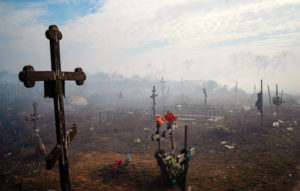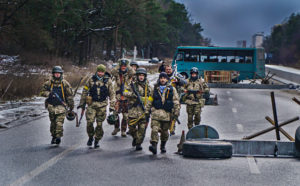On August 20, 1968, I happened to be in Prague when Czechoslovakia was simultaneously invaded from East Germany, Hungary, Poland and western Ukraine by more than 800,000 Warsaw Pact troops making any resistance futile. By contrast, on February 23 this year, the day before Putin launched his invasion of a country more than four times as big as Czechoslovakia, Russian field forces numbered fewer than 140,000, a figure that included field dentists and the like.
Even before the invasion was launched, it was already clear that the Russians had made an elementary military mistake: their generals, just like their American counterparts, were intoxicated by the techy verbiage of “Fourth Generation”, “post-modern information”, and “hybrid” warfare. Hoping to mimic their effectiveness in war games, cyberwar attacks and social-media disinformation were to be artfully combined with precision missile strikes to paralyse the Ukrainian resistance.
Hidden in all this was another delusion: that fighting the Ukrainians would be no different than fighting the sectarians the Russian officers had encountered in Syria and Libya. This view was also shared by the US intelligence community, which was so impressed by the Russian plan that it had frightened the White House into evacuating its diplomats, dissuaded any last-minute airlift of weapons as futile, and prepared to evacuate Zelensky.
That the same intelligence officials are still in charge is unfortunate, for it appears they are again failing to report accurately what is happening in this war — even though an elementary analysis of published information is quite sufficient to reveal what is going wrong. In short, increasingly uncontrollable escalation processes are underway, bringing closer the danger that the Kremlin might even perhaps consider detonating a nuclear weapon to stop the downward spiral of its loss of power and authority.
Early on, the Biden Administration acted with great clarity when rejecting demands for a “no-fly zone” over Ukraine. From the President down, officials pointed out that in the absence of enough surface-to-air missile batteries which would take years to deploy, the only way of protecting Ukraine’s airspace was to patrol it with US fighters ready to shoot down intruders, thus initiating direct US-Russian combat that would breach the strongest barrier to nuclear escalation.
There is no such clarity now. When the Ukrainians deployed locally manufactured R-360 Neptune anti-ship missiles to help protect Odessa from amphibious landings that seemed imminent, they did not institute command-and-control arrangements that would subordinate the local battery commander to headquarters in Kyiv. Instead, identified Russian warships were to be engaged without further ado, since any hesitation could be fatal in the context of an amphibious assault that would certainly be accompanied by aerial bombing and missile strikes.
As it happened, the imminent threat of an amphibious landing came and went, but the arrangement that cut out Kyiv HQ remained in place. The result was the destruction of the heavy cruiser Moskva, which served as the Russian navy’s flag and command vessel in the Black Sea. Given that the sinking was bound to provoke retaliation, Kyiv might have preferred to let it be. But it was not consulted; had it been, it might well have denied permission to engage, if only because a US Navy P-8 Poseidon maritime reconnaissance aircraft was flying over the Black Sea at the time — quite enough to inspire Russian accusations of complicity, again raising the dangers of escalation at a time when Putin’s army is already under great pressure.
At the time of writing, the Russian army has committed an extraordinarily high proportion of its deployable combined-arms battalion groups. Their grand total on paper across the vastness of the Russian Federation comes to some 170, including low-readiness and incomplete formations, with 120 a more realistic number. Of these, 76 were last counted inside the borders of Ukraine, not including an unknown number withdrawn after suffering heavy losses of machines and men (including the three that comprised the 64th Motorized Rifle Brigade commanded by Azatbek Asanbekovich Omurbekov, the Karakalpak colonel accused of the Bucha cruelties and killings).
What this means is that the Russian army is greatly stretched, already reliant on unwilling conscripts, very few of whom seem to be eager to fight, while the much-filmed Chechens and rumoured Syrians can only frighten unarmed civilians not fight in earnest. By contrast, while Ukraine’s soldiers and gendarmes on duty at the start of the war have been depleted by combat losses, accidents and disease, a great many conscripts and volunteers, including returning emigrants, are reinforcing their units. Compared to the start of the war, they are also much better equipped, even though the just delivered weapons, US-made M-777 155mm towed gun-howitzers (superior in range to their Russian 152mm counterparts), British AS.90 155mm gun-howitzers, Stormer vehicles with new anti-aircraft missiles, M113 troop carriers thinly armoured but better than nothing, are not yet in combat unlike the ex-Soviet tanks from ex-Warsaw Pact countries, and the shoulder-launched missiles made famous by this war.
Still, so much more could be sent, and that is the priority of the growing Ukraine-victory lobby that stretches from the US to Finland, with notable outposts in Germany’s once-pacifist Green Party and in Downing Street. This loose but influential lobby holds that victory for Ukraine is a victory for Nato and the West, so defeat for Ukraine must mean their defeat as well. It follows that enough military support must reach Ukraine to allow it to expel Russia’s forces, including in the Donetsk and Luhansk regions.
For this lobby, the greatest short-term threat is a ceasefire or, even worse, an armistice with Russian forces still in control of Ukrainian territory, providing a dangerous bargaining chip for Moscow. It sees a perilous contradiction between what satisfactory short and medium-term results look like for Ukraine, and what many Western leaders might accept to stop the violence, including allowing Russia to hold on to the territory it gained. It sees Ukraine losing the war unless it receives much more Western support, including heavy weapons with the requisite training. And it sees Nato’s role as ensuring Ukraine drives out all Russian troops, with the hope that Putin himself will be driven out of office.
Unlike the victory lobby, I see the makings of a solidly satisfactory outcome in the present situation, so long as enough aid reaches Ukraine to keep up its strength — and that means reading the riot act to double-dealing Chancellor Olaf Scholz — while vigorously proposing a peace plan. After all, the two sides have already reached agreement on the broadest issues: Zelenskyy has already stated that Ukraine will not join Nato and the Russian side has already accepted Ukraine’s entry into the European Union.
That leaves the disposition of the Donetsk and Luhansk oblasts, substantial territories that Zelensky does not have the authority to give up, and without which Putin cannot leave the table where he has gambled and lost so much. While Putin cannot be given the two regions he demanded before starting the war, he can be provided with something that he can portray as a victory: plebiscites in both regions where properly certified residents, including returning refugees, would be allowed to vote on whether their oblast should remain Ukrainian or join Russia.
Upon acceptance of the plebiscites in principle, a cease-fire would come into immediate effect, with Russia’s respect of their terms guaranteed by the ease of reimposing sanctions just lifted.
It is axiomatic that both sides must benefit if they are to end the war. For Ukraine, this must include its unconditional recognition as an independent state, as well as the cessation of hostilities that would bring with it the return of millions of refugees and the arrival of a flood of reconstruction aid from the EU, US and Japan. As for Russia, the lifting of all sanctions would bring immediate benefits across the country, from the re-opening of the McDonald’s in Omsk where I once had the best meal the town could offer at 6am, to the resumption of normality for the great number of Russians whose lives have become international, whether they know it or not.
There is a model for this. Plebiscites proved surprisingly effective after the Versailles Treaty in disputed territories ranging from Belgium to Poland. In spite of the enormous devastation and loss of life brought about by the Great War, and the bureaucratic shortcomings of newly formed states, the votes in 1919 went well enough to prevent further border wars. And with today’s fast documentation techniques, they would be even more effective, allowing Ukraine’s reconstruction to start without delay.
All of this is anathema for the victory lobby. But its twin goals of driving out the Russians by force and bringing down Putin in the process would only be desirable if nuclear weapons could be un-invented. As it is, they offer Russia a court of appeal when facing conventional defeat, in a manner that negates any conventional victory — something that is surely infinitely worse than the outcome of any referendum.
Disclaimer
Some of the posts we share are controversial and we do not necessarily agree with them in the whole extend. Sometimes we agree with the content or part of it but we do not agree with the narration or language. Nevertheless we find them somehow interesting, valuable and/or informative or we share them, because we strongly believe in freedom of speech, free press and journalism. We strongly encourage you to have a critical approach to all the content, do your own research and analysis to build your own opinion.
We would be glad to have your feedback.
Source: UnHerd Read the original article here: https://unherd.com




